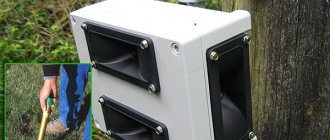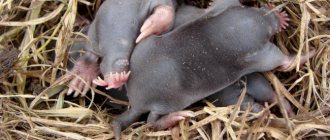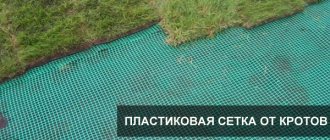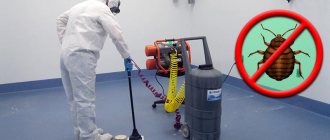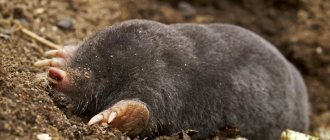The lawn on your home's lawn will be ruined if moles appear on the property. Numerous traditional and modern (nanotechnological) methods of combating these animals do not bring the desired effect. For example, the use of poisons, smoke bombs, ultrasonic and vibration repellers often gives temporary results. But! There is a simple and effective way - a plastic mesh against moles. It prevents moles from entering the lawn, as a result of which the mole cannot create feeding passages.
What is the danger from moles on the site
Small mammals are real cuties, but only in pictures. In nature, these are carnivorous predators up to 17 cm long. Moles live only in the thickness of the soil, weigh up to 70 g and the female bears up to two offspring per year. The animal's body is covered with soft fur, suitable for making clothing, so moles are also commercially hunted.
The main problem for gardeners is the rodent's front paws, which are crowned with large and hard claws. By raking with its paws, the animal can dig up to 20 m of tunnels per day. The rest of the body is weaker. While digging a molehill, the individual screws its muzzle into the smallest holes and instantly widens the hole with its paws. Moles are blind by nature, but have a keen sense of hearing and touch, so they often avoid poisonous baits and traps.
Why use mole nets and other methods of exterminating animals:
- Voracious individuals eat any insects, without understanding whether they are useful for the garden or not. And if there are no mole crickets, the moles will eat the earthworms that loosen the soil in the garden. Cannibals by nature, animals eat their offspring and can attack a weaker relative.
- On its way, the mammal tears apart everything it gets its hands on. The roots of plants, trees, cables, and water pipes suffer.
- Mice and rats instantly appear in old molehills. One family of such pests can destroy the entire crop on the site.
All rodents are carriers of diseases dangerous to humans. Fleas settle on the skin of animals, and there may be worm eggs in the excrement and saliva. Work on the destruction of animals is carried out with gloves. You cannot pick up moles; they are quite aggressive animals that can bite or scratch.
Is it possible to replace the mesh with slate, roofing felt or other barrier means?
A household summer resident may immediately have questions: is it possible to replace the mole net with something more economical?
Let's see which options are the most popular:
- Slate - a sheet of wave slate costs 190 rubles, its dimensions are 1.12 x 1.75 m. If you cut each sheet in the middle, you will get 2 sheets with a total length of 2.2 m and a height of 87 cm (in principle, sufficient for protection against moles). The price per meter of protection will be 86 rubles. - more expensive than the Italian mesh, but cheaper than the domestic one;
- Roofing felt - suppose we use rolls 1 meter wide and 10 meters long, the price of such a roll is approximately 500 rubles. The price of 1 m will be 50 rubles. It is important to understand that roofing material does not provide reliable protection against moles, since the animal can tear it with its strong clawed paws and crawl into the hole.
Other options - boards, crushed stone, metal sheets, strip foundation - are always more expensive than mesh, both in cost and installation cost. They are convenient to use when a summer resident has large old stocks of such materials or cheap illiquid goods.
It is important to remember that all means, except for the net, complicate the migration across the boundaries of the site not only of moles, but also of other soil inhabitants, which are often very useful and necessary on the site (and earthworms are far from the only example). If the area is large (more than 10 acres), then this is not critical, since the soil biocenoses on it are restored on their own, and migration also occurs along the soil surface, above the fence. But in small areas, such continuous barriers can lead to a noticeable depletion of the diversity of soil organisms.
In some cases, it is impossible to discount the deterioration of moisture removal from the site if it is fenced on all sides with slate sheets. After heavy rainfall or melting snow, the entire area can turn into a swamp, the boundaries of which are outlined by slate or roofing felt protruding above the ground.
Mole protection net, how does it work?
The mole net is a continuous fabric made of durable materials. The cellular structure does not restrict air access to plants, but stops the movement of pests. The smaller the cells, the more effective the protection. In addition to moles, the net helps protect plantings from other rodents.
The operating principle is simple:
- The canvas is buried 10-15 cm into the ground so that it blocks the rodent from coming to the surface.
- When faced with a barrier, the mole is forced to dig a new hole. When constructing protection throughout the entire area, shrews will not break through to throw out soil, and therefore will abandon their inhospitable owners.
In theory, there is no problem with using a mesh under the lawn, but in practice the situation is a little more complicated.
Nuances of choice
There are several ways to lay out protection - vertical, horizontal, universal. The work ahead will be extensive and difficult - you will have to lift the soil, dig trenches or hire equipment. Savings in this case will come at the cost of ineffective measures, so it is worth including all the costs for protection and subsequent development of the site.
Which mole net to choose:
- Metal cloth. The material, which is not resistant to rust, will require replacement after a few years. You will have to re-raise the soil and re-layer the protection, otherwise moles, mice and rats will gain full access to the surface of the soil.
- Plastic construction. A more durable material that can withstand aggressive conditions, water, and frost. Plastic does not rot or rust, and by choosing polypropylene products, the owner has the hope that rats will not be able to cope with the protective fabric.
As for cell sizes, the smaller the better. The optimal option is a clearance of up to 25 mm. Even mice, the faithful “companions” of moles in the country, will not penetrate such a hole.
Choosing the right material
Nets for protection against moles
The net has different cell diameters and is made of metal or modern polymer. To ensure a complete barrier, you need to take into account the size of the mole and the principle of its activity. The animal is small, averaging 13 cm in length. The body is flexible, oblong. The animal digs the ground with its front shovel-shaped paws with long claws, screws its muzzle and entire body into the hole. It throws away the soil with its hind paws. The cell size should be as small as possible, otherwise the mole will overcome the obstacle. Acceptable value is 25*25 mm.
The second very important point is the material. Iron mesh is strong, reliable, but short-lived. The material is in the ground, subject to deformation, corrosion, gradually rusting, and losing strength. In a few years, the mole will be able to break through, gnaw through the cells, and get into the garden bed, lawn, or garden. This drawback has been eliminated by manufacturers of modern anti-mole netting made from polymer materials.
On a note!
The plastic construction is extremely strong, durable, not exposed to the negative effects of moisture, resistant to frost and microorganisms. By installing a barrier on the lawn according to all the rules, you can forever forget about fighting moles on your site.
Features of installing protective fabric
There are several options for laying out anti-mole mesh under the lawn:
- Laying around the perimeter of the entire garden. This will protect the area from pests from the outside. Used for dachas with an area of up to 30 acres. If the site is fenced with a fence on a strip foundation, the mole net is dug in from the unprotected side. A depth of up to 0.8 m will allow all entrances/exits to be blocked.
If there are moles in the ground during the period of work, they are caught. Otherwise there will be no result.
- Horizontal layout. The soil is raised by 100-150 mm, then a protective sheet is laid out and covered with earth again. Be sure to carefully connect the sheets to prevent the mole from moving the mesh and throwing the soil out. The method is suitable only if the lawn is arranged. If the mesh under the lawn is laid on an area for planting bushes or beds, choose a different method.
The disadvantage of horizontal laying out is that rodents can easily dig feeding passages above the canvas. For example, there were mole rats up to 50 mm in size on the site, and the canvas was buried 150 mm. Pests will feel at ease in the soil; protection will not hinder them at all.
- Vertical or island display. Used in limited areas where it is necessary to protect the bed from rodent invasion. The structure is deepened by 150-200 mm, and up to 300 mm of mesh is also brought up. Convenient for high beds, but inconvenient for flower beds.
Before buying mole nets, it is worth considering all the advantages and disadvantages of using canvas.
Operating principle
The anti-mole net is installed in a horizontal or vertical position. In the first case, it serves as a barrier to prevent moles from entering the area. It digs to a certain depth and does not allow the mole to make a passage. Since underground diggers dig tunnels at a level of 10-100 cm from the surface, it is advisable to bury the protective mesh at 150-200 cm.
The second installation option involves placing a grid over the entire plot of land at a certain depth. When digging tunnels and burrows, moles throw soil to the surface and form molehills. Not having received such an opportunity, the animal moves to the territory where this can be done.
On a note!
The principle of operation is extremely simple, but there are some nuances. Mole netting under the lawn does not always give the desired results. Despite the ease of use, there are certain rules that must be followed.
Advantages and disadvantages of mole nets
The undoubted advantages include:
- material strength and long service life;
- a humane method of controlling moles;
- the ability to eliminate the threat not only from shrews, but also other rodents.
And a little about the disadvantages that the users themselves identified:
- There is a lot of earthwork to be done. In the end, everything may turn out to be in vain - the mole hid in the ground, it was not found, and the area was fenced off. After some time, the individuals multiplied and continued to damage the garden.
- You can't fence an entire garden with a net. Manufacturers emphasize that this is a mesh for a lawn, that is, for a plot of land without annual cultivation.
- If it is necessary to dig up an area, the protective sheet must be lifted, removed, and then laid down again. An incredible waste of effort, time and money.
- The root system of some crops may be damaged by nets, which will affect flowering and yield.
Also, users on forums note the low efficiency of the canvas. In particular, when burying a net under a compost pit to preserve fertilizer from rats, the owners were faced with considerable holes in the protection after just six months. Moles cannot chew plastic, but rats and mice chew through canvas with great success. Knowing that other rodents always live in molehills, you should choose very dense and high-quality mole nets. And this is an increase in the estimate, which is not always feasible for a summer resident.
Despite the disadvantages, mole netting is in demand and has proven itself especially useful for lawns. Lawns with grass do not need to be dug up, so laying a protective cloth here would be a good solution. As for beds and orchards, you should look for a more effective option.
Popular manufacturers
There are several brands of mole netting that, according to reviews, have proven themselves to be a reliable means of protecting against moles and for strengthening lawns.
Tenax
The Tenax brand (Italy) is represented on the market with several modifications of extruded polypropylene mesh:
- S-38, cell size 12x14 mm;
- Syntoflex E, cell size 13x15 mm;
- Aviary, cell size 16x19 mm.
All modifications have black color, width – 1 or 2 m, roll length – 50 and 200 m.
The high quality of polymer products is evidenced by international certificates and an excellent reputation in the European market.
Lawn mesh Grinda against moles
The Grinda company (Lithuania) specializes in the production of tools, equipment and materials for gardening, vegetable gardens and lawns.
Mole net CP 15
Material – polypropylene, mesh size 15x15 mm, width – 1 m, length – 20 m. Thanks to its green or blue color, it can be used as a decorative mesh, which looks good as a fence around the area. The manufacturer (Russia) positions it as a garden lattice for arranging hedges, protecting the area from birds and rodents. When installed vertically around the perimeter in the ground, it is a reliable means of protection against moles.
Methods for eliminating moles other than mesh
What to do if underground pests have multiplied, but the owners are not ready to spend tens of thousands of rubles - buy an EcoSniper LS-997R mole repeller. This is a device for all-season use, operating on the principle of delivering an ultrasonic signal. Thanks to their acute hearing and sense of smell, shrews perfectly hear the entire spectrum of sounds and, at the slightest discomfort, quickly leave their burrows. EcoSniper LS-997R delivers ultrasound in a range that humans cannot hear, but is perfectly detected by moles, rats, mice and other pests. In terms of power output, the signal is similar to the roar of an airplane turbine. Animals cannot stand such noise and therefore try to go to a quieter place as quickly as possible.
Unlike a mole net, the repeller does not need to be buried around the entire perimeter; it is buried in one point of the garden and turned on. All. The device will perform further work itself. In order to completely expel pests, the device is turned on at a certain period of time. Then once a season a preventive inclusion is made. Mole repeller EcoSniper LS-997R does not kill animals, does not cause them physical harm, and is safe for humans and pets. Depending on the power, the device covers up to 45 meters, so the radiation of the wave will affect not only the beds, but also the cellar, basement, garage - all those places where rodents love to live.
By purchasing EcoSniper LS-997R, the owner receives a guaranteed result without tedious excavation work. And to choose a repeller, call our operators. An experienced manager will help you choose a device that is suitable for individual conditions of use, terrain and other features of the site. And remember, moles do not hibernate in winter, so now is the time to take care of preserving the harvest.
Efficient Products
Anti-mole nets
When choosing suitable products, you need to focus not only on price, but also on quality. It is worth paying attention to the following brands.
Protect G8
The Protect mole net has a small cell diameter – 8*6 mm, which ensures reliable protection. Additionally prevents soil displacement. Durable polymer material does not rot, does not deteriorate, and prevents teeth from biting. Manufacturers guarantee protection for 25 years. The price of a 2*30 m roll is 9,500 rubles. This manufacturer has other products that differ only in cell diameter.
Review
Protected the lawn. They dug to a depth of 20 cm. They installed a grid lengthwise and crosswise. I haven’t seen Krotovin for 2 years. We spent once, now we live in peace. This is a great thing, I recommend everyone install it before planting crops.
Irina, Moscow
Syntoflex
Italian-made products are distinguished by their material flexibility, strength, and durability. Cell size 12*14 mm. The material is resistant to corrosion, erosion, rotting, and provides protection for 25 years. The cost of a 2*100 cm roll is 14,000 rubles. Reviews of the mole net from this manufacturer confirm the high efficiency of the design.
Review
Last year, moles ruined the entire flowerbed with tulips. I am not a fan of killing; I was not able to catch all the moles. This year I decided to install mesh protection on the lawn. I installed a barrier along the borders of the flowerbed, along the entire bed as a continuous sheet. The protection worked great, no problems with these animals.
Oleg, Voronezh
You can buy mole nets for lawns in a specialized store or order online. Cost from 1500 rub. per roll up to 20 thousand rubles. How long the protection will last depends on the quality of the product.
